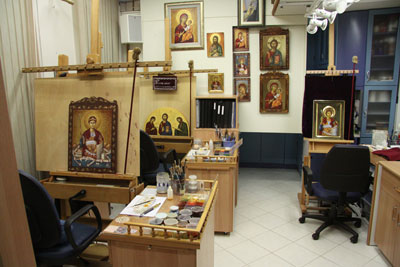Translated excerpts from the book:
Στεργίου Ν. Σάκκου [Read CV], Ὁ Σταυρός στό φῶς τῆς Ἀνάστασης, ἐκδ. «ΧΡΙΣΤΙΑΝΙΚΗ ΕΛΠΙΣ» ΟΡΘΟΔΟΞΗ ΑΔΕΛΦΟΤΗΤΑ, Θεσ/νίκη 2019
If someone were to tell us that we could hold God in the palm of our hand, we would likely consider it an exaggeration—perhaps even a blasphemy. How could the Infinite and Eternal One be confined within the grasp of five fingers? And yet, the One who surpasses time and space took on flesh and bones in the womb of a Virgin. He showed us how He can dwell with His body and blood in the very heart of a human being. His supreme condescension to our human nature is revealed time and again in the life of the Church. It gives us the assurance to accept this truth with confidence. Yes, it is true. He who holds the universe in His hands and directs life and history by His providence, allows Himself to be embraced in the palm of a faithful Christian. Through the sign traced with the right hand, we make our Christian confession.
 Speaking of the great mystery of faith—the Incarnation and the Resurrection of Christ—the apostle Paul speaks with clarity. Τhis wondrous work of God is fulfilled. It moves from being a historical reality to becoming a present reality in our lives. And it is accomplished through a “word”. A single utterance holds all its power: “the word of faith.” “But the righteousness based on faith says, Do not say in your heart, 'Who will ascend into heaven?' (that is, to bring Christ down) or 'Who will descend into the abyss?' (that is, to bring Christ up from the dead). But what does it say? 'The word is near you, on your lips and in your heart' (that is, the word of faith which we preach); because, if you confess with your lips that Jesus is Lord and believe in your heart that God raised him from the dead, you will be saved” (Rom 10:6–9). Our salvation depends on a confession made in faith. And God Himself is marked by a sign made in faith: the sign of the Cross.
Speaking of the great mystery of faith—the Incarnation and the Resurrection of Christ—the apostle Paul speaks with clarity. Τhis wondrous work of God is fulfilled. It moves from being a historical reality to becoming a present reality in our lives. And it is accomplished through a “word”. A single utterance holds all its power: “the word of faith.” “But the righteousness based on faith says, Do not say in your heart, 'Who will ascend into heaven?' (that is, to bring Christ down) or 'Who will descend into the abyss?' (that is, to bring Christ up from the dead). But what does it say? 'The word is near you, on your lips and in your heart' (that is, the word of faith which we preach); because, if you confess with your lips that Jesus is Lord and believe in your heart that God raised him from the dead, you will be saved” (Rom 10:6–9). Our salvation depends on a confession made in faith. And God Himself is marked by a sign made in faith: the sign of the Cross.
By joining the three fingers of our right hand into one, we signify the three persons of the Holy Trinity: the Father, the Son, and the Holy Spirit. Being of one essence, they are the one God. By folding the other two fingers together and placing them side by side, we declare the two natures that are united without confusion and without division in the person of our Lord, the God-man. Then, by tracing the sign of the Cross upon our body—with the hand on the forehead, the belly, the right shoulder, and the left—we recall the means of our salvation: the crucifixion of Christ. Through His Cross, He granted to humanity the resurrection of the dead bodies and to the Church the glory of the deification of her members. At the same time, we declare that we are crucified with the Lord, as members of His Body. In this simple act, the highest dogmas of our faith are expressed: the Trinitarian doctrine and the Christological doctrine. These are the very truths on which the ecumenical Councils of our God-inspired Fathers reflected and gave their verdict. The experienced elder and the unlearned child, the wise scholar and the humble laborer—all alike can confess the truths of the faith in this way, so long as they are Orthodox believers. And before these truths, even the angels stand in awe.
The sign of the Cross is rooted in the treasury of the Orthodox tradition, and it retains its meaning only when traced according to the way it has been handed down through the centuries. Above all, of course, it is connected with faith. It is neither an external form nor a magical symbol, but a confession of a particular faith and an invocation of a personal God. We acknowledge that God is Triune and we seek the grace that flows from the Cross of the Incarnate Lord. The immediate consequence is that it must be traced properly, fully, and completely. The hurried and careless manner that distorts its form so that it no longer resembles the Cross is unacceptable, for it reveals the absence of the most essential element: awareness and understanding. Even if we do everything correctly, but in the end neglect to complete the sign by placing our hand properly on the left shoulder, then our Cross has no validity. This is taught to us beyond any doubt by the posture of Moses’ prayer at the time when the Israelites fought against the Amalekites. As long as he kept his hands stretched wide, forming with his body the shape of a complete cross, the Israelites prevailed. But when he began to grow weary and his hands drooped and fell, changing the shape, the Israelites were defeated—even though Moses, with all his heart, continued to pray fervently. Aaron on one side and Hur on the other came to support his arms, holding them outstretched in the perfect likeness of the Cross, until the Israelites at last gained the victory. Even the slightest deviation causes the sign to lose its meaning. It’s like dialing a phone number and mistaking just one digit—one small error is enough to prevent the person you are looking for from ever answering. And could this not be the very reason we so often complain that God does not hear our prayers?
It is remarkable that one of the great missionaries of the Church, Saint Kosmas of Aetolia, persistently taught during the difficult years of the Turkish occupation that Christians should make the sign of the Cross correctly. For indeed, the Ark was for Israel the place where the symbols of the Covenant were kept. The holy Altar tabernacle (artophorion) is for the Church the place where the Body and Blood of Christ are reserved. In the same way, the sign of the Cross is the place where the doctrine of faith and salvation is safeguarded. With this, every Christian can carry intact the full treasure. It is the inheritance that God has entrusted to us. Truly, the highest honor we can offer the precious Cross of our Lord is to resolve always to make the sign of the Cross correctly, with faith and with reverence.









